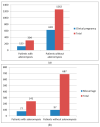Impact of Adenomyosis on Infertile Patients-Therapy Options and Reproductive Outcomes
- PMID: 36552001
- PMCID: PMC9775960
- DOI: 10.3390/biomedicines10123245
Impact of Adenomyosis on Infertile Patients-Therapy Options and Reproductive Outcomes
Abstract
Adenomyosis is associated with a negative impact on reproductive outcomes. Although adenomyosis is detected more frequently in women of late reproductive age, its impact on pregnancy rates is important because, in today's world, family planning has shifted towards the late reproductive phase of life for many women. Although the diagnostic indications for imaging studies are well-known, we lack strict diagnostic criteria and classification systems concerning the extent of the disease. Selecting the optimal evidence-based treatment option for adenomyosis is difficult because of the paucity of evidence concerning the association between fertility and the degree and composition of adenomyosis. Furthermore, the treatment of infertility might interfere with the treatment of adenomyosis due to the presence of pain. The aim of this review is to analyze the association between adenomyosis and infertility, and describe treatment options to enhance reproductive outcomes. The following aspects will be addressed in detail: (a) prevalence and causes of adenomyosis, (b) diagnostic tools with imaging techniques, (c) clinical symptoms, (d) proposed pathomechanism of adenomyosis and infertility, and (e) different treatment approaches (pharmacological, surgical, others) and their impact on reproductive outcomes.
Keywords: adenomyosis; diagnosis; infertility; reproductive outcome; treatment options.
Conflict of interest statement
The authors declare that there are no conflicts of interest.
Figures




Similar articles
-
Adenomyosis and Infertility: A Literature Review.Medicina (Kaunas). 2023 Aug 26;59(9):1551. doi: 10.3390/medicina59091551. Medicina (Kaunas). 2023. PMID: 37763670 Free PMC article. Review.
-
Uterine adenomyosis and infertility, review of reproductive outcome after in vitro fertilization and surgery.Acta Obstet Gynecol Scand. 2017 Jun;96(6):715-726. doi: 10.1111/aogs.13158. Acta Obstet Gynecol Scand. 2017. PMID: 28556124 Review.
-
Adenomyosis and Infertility-Review of Medical and Surgical Approaches.Int J Environ Res Public Health. 2021 Jan 30;18(3):1235. doi: 10.3390/ijerph18031235. Int J Environ Res Public Health. 2021. PMID: 33573117 Free PMC article. Review.
-
The Impact of Adenomyosis on Women's Fertility.Obstet Gynecol Surv. 2016 Sep;71(9):557-68. doi: 10.1097/OGX.0000000000000346. Obstet Gynecol Surv. 2016. PMID: 27640610 Free PMC article. Review.
-
Treatment options and reproductive outcome for adenomyosis-associated infertility.Curr Med Res Opin. 2018 May;34(5):839-849. doi: 10.1080/03007995.2017.1393404. Epub 2017 Nov 10. Curr Med Res Opin. 2018. PMID: 29046066 Review.
Cited by
-
Improvement of early miscarriage rates in women with adenomyosis via oxytocin receptor antagonist during frozen embryo transfer-a propensity score-matched study.Reprod Biol Endocrinol. 2024 Jul 12;22(1):79. doi: 10.1186/s12958-024-01255-1. Reprod Biol Endocrinol. 2024. PMID: 38997744 Free PMC article.
-
Retrospective study of the factors involved in the development of adenomyosis and the in vitro link between adenomyosis and breast cancer.Med Pharm Rep. 2024 Oct;97(4):477-487. doi: 10.15386/mpr-2747. Epub 2024 Oct 30. Med Pharm Rep. 2024. PMID: 39502755 Free PMC article.
-
Adenomyosis and Infertility: A Literature Review.Medicina (Kaunas). 2023 Aug 26;59(9):1551. doi: 10.3390/medicina59091551. Medicina (Kaunas). 2023. PMID: 37763670 Free PMC article. Review.
-
Scientific landscape and visualization analysis of the link between adenomyosis and infertility from 2000 to 2024.Front Med (Lausanne). 2025 Feb 19;12:1488866. doi: 10.3389/fmed.2025.1488866. eCollection 2025. Front Med (Lausanne). 2025. PMID: 40046932 Free PMC article.
References
-
- Graziano A., Monte G.L., Piva I., Caserta D., Karner M., Engl B., Marci R. Diagnostic findings in adenomyosis: A pictorial review on the major concerns. Eur. Rev. Med. Pharmacol. Sci. 2015;19:1146–1154. - PubMed
Publication types
LinkOut - more resources
Full Text Sources

